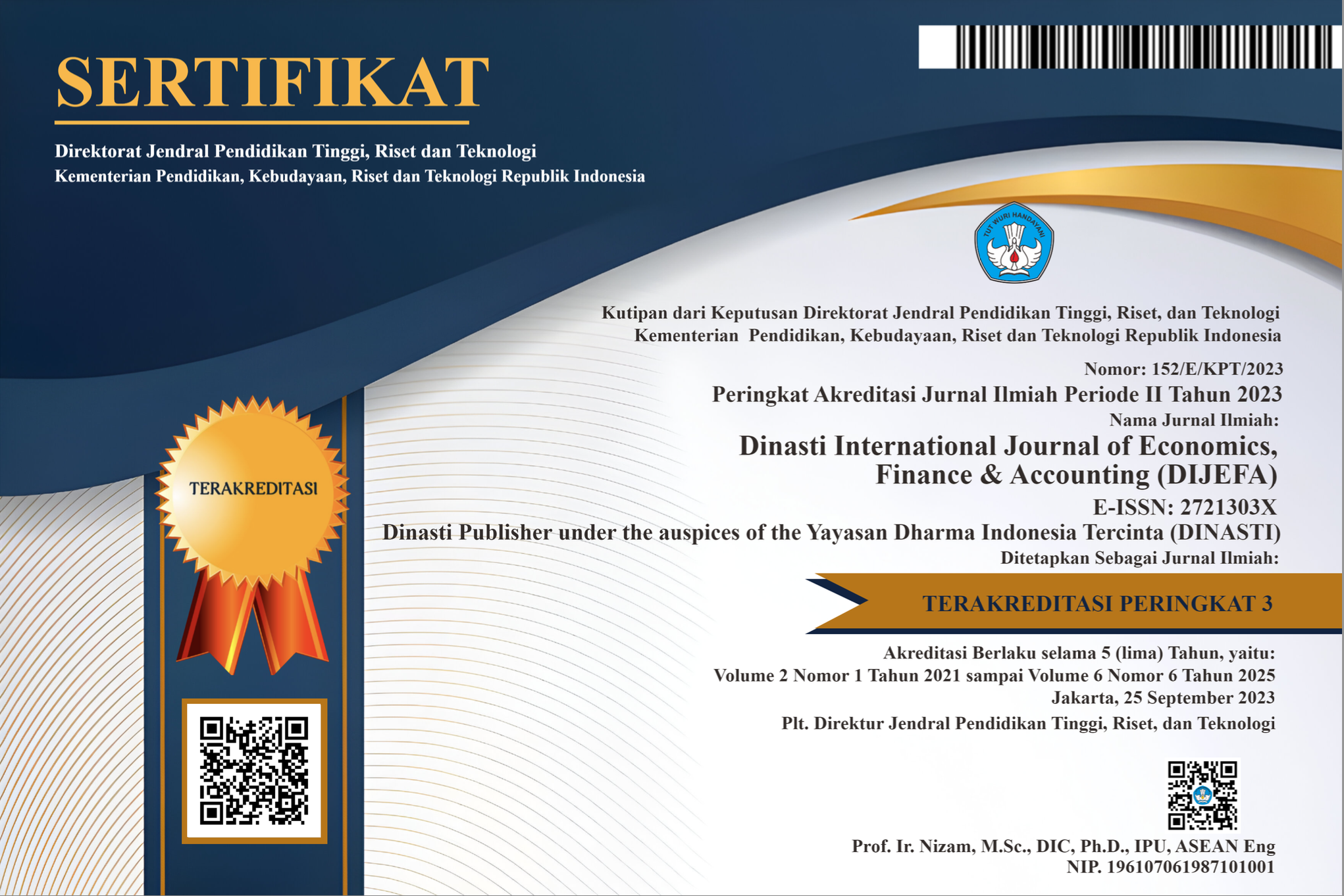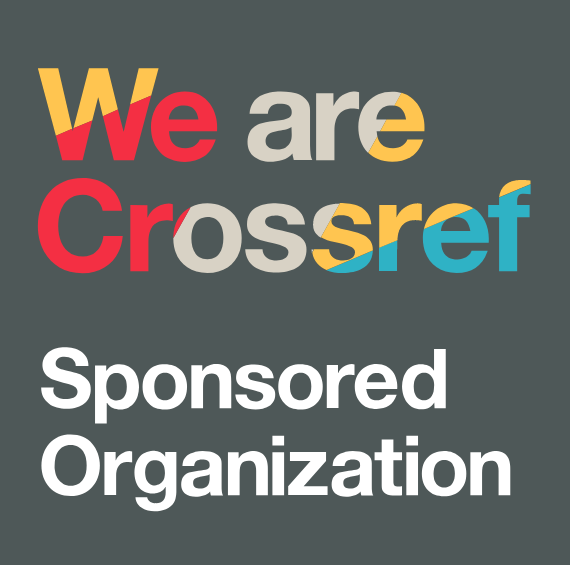The Phenomenon of Tax Aggressiveness is Associated with Capital Intensity, Inventory Intensity, profitability, and Leverage
DOI:
https://doi.org/10.38035/dijefa.v5i3.3028Keywords:
Tax Aggressiveness, Capital Intensity, Inventory Intensity, Leverage, ProfitabilityAbstract
Tax aggressiveness is an activity or reconstruction effort carried out with the aim of maximizing contributions to the company through tax management strategies. This study aims to analyze the effect of capital intensity, inventory intensity, profitability, and leverage on tax aggressiveness. The population studied was property and real estate companies listed on the Indonesia Stock Exchange from 2019 to 2022. Sampling using a purposive sampling method. The number of samples as many as 61 companies. Data collection techniques through documentation techniques using secondary data sources. Data analysis using multiple linear regression using statistical Application Program tools: Statistical Product and Service Solutions (SPSS). The results of this study showed that capital intensity, and profitability affect tax aggressiveness, while inventory intensity, and leverage did not affect tax aggressiveness.
References
Adnyani, N. K. A., & Astika, I. B. P. (2019). Pengaruh profitabilitas , capital intensity, dan ukuran perusahaan pada tax aggressive. E-Jurnal Ekonomi Dan Bisnis Universitas Udayana, 8(6), 594–621.
Andhari, P. A. S., & Sukartha, I. M. (2017). Pengaruh Pengungkapan Corporate Social Responsibility, Profitabilitas, Inventory Intensity, Capital intensity Danleverage Pada Agresivitas Pajak. E-Jurnal Akuntansi Universitas Udayana, 18.3(2017), 2115–2142.
Anggriantari, C. D., & Purwantini, A. H. (2020). Pengaruh Profitabilitas, Capital intensity, Inventory Intensity, Dan Leverage Pada Penghindaran Pajak. Jurnal Unimma, 137–153. http://repository.uin-suska.ac.id/58893/
Augustpaosa Nariman, J. J. T. (2021). Faktor-Faktor Yang Mempengaruhi Tax Avoidance Perusahaan Manufaktur Yang Terdaftar Di BEI. Jurnal Paradigma Akuntansi, 3(4), 1498. https://doi.org/10.24912/jpa.v3i4.14966
Azizah. (2021). Model terbaik uji multikolinearitas untuk analisis faktor-faktor yang mempengaruhi produksi padi di Kabupaten Blora tahun 2020. Prosiding Seminar Nasional UNIMUS, 4, 61–69. https://scholar.google.com/scholar?as_ylo=2021&q=uji+autokorelasi+adalah&hl=id&as_sdt=0,5
Dinar, M., Yuesti, A., & Dewi, N. P. S. (2020). Pengaruh Profitabilitas, Likuiditas Dan Leverage Terhadap Agresivitas Pajak Pada Perusahaan Manufaktur Yang Terdaftar Di Bei. 2(1), 66–76.
Efrinal, E., & Chandra, A. H. (2021). Pengaruh Capital intensity Dan Inventory Intensity Terhadap Agresivitas Pajak. AKRUAL?: Jurnal Akuntansi Dan Keuangan, 2(2), 135–148. https://doi.org/10.34005/akrual.v2i2.1268
Fahriani, M. (2016). Pengaruh Good Corporate Governance Terhadap Tindakan Pajak Agresif Pada Perusahaan Manufaktur. Jurnal Ilmu Dan Riset Akuntansi , 5(7), 1–20.
Herlinda, A. R., & Rahmawati, M. I. (2021). Pengaruh Profitabilitas, Likuiditas, Leverage Dan Ukuran Perusahaan Terhadap Agresivitas Pajak. Ilmu Dan Riset Akuntansi, 10, 18.
Hidayat, A., & Muliasari, R. (2020). Pengaruh Likuiditas, Leverage dan Komisaris Independen Terhadap Agresivitas Pajak Perusahaan. SULTANIST: Jurnal Manajemen Dan Keuangan, 8(1), 28–36. https://doi.org/10.37403/sultanist.v8i1.183
Hidayat, A. T., & Fitria, E. F. (2018). Pengaruh Capital intensity, Inventory Intensity, Profitabilitas dan Leverage Terhadap Agresivitas Pajak. Eksis: Jurnal Riset Ekonomi Dan Bisnis, 13(2), 157–168. https://doi.org/10.26533/eksis.v13i2.289
Himawan, A. (2017). Fitra:SetiapTahun,PenghindaranPajakCapaiRp110Triliun. Suara.Com.
Jensen, M. C., & Meckling, W. H. (1976). Theory of the Firm: Managerial Behavior. Journal of Financial Economics.
judith freedman. (2003). Tax and corporate responsibility. Tax Journal.
Kasmir. (2016). Analisis Laporan Keuangan. Raja Grafindo Persada.
Maulana, I. A. (2020). Faktor - Faktor Yang Mepengaruhi Agresivitas Pajak Pada Perusahaan Properti Dan Real Estate. 11(2), 155–163.
Megawati, O.?:, Tawas, A., Ekonomi, F., Bisnis, D., Akuntansi, J., Sam, U., & Manado, R. (2015). Analysis the Determination Sale Value of Tax Object and Its Implications for Land and Building Tax Revenue At Kotamobagu City. Jurnal EMBA, 874(1), 874–882.
Mujiyati, M., Aris, M. A., & Zulfikar, Z. (2022). Tax amnesty and company value: Testing tax avoidance as an intervening variable. Investment Management and Financial Innovations, 19(3), 176–188. https://doi.org/10.21511/imfi.19(3).2022.15
Mustika. (2017). Pengaruh Corporate Social Responsibility, Ukuran Perusahaan, Profitabilitas, Leverage, Capital intensity dan Kepemilikan Keluarga terhadap Agresivitas Pajak (studi empiris pada perusahaan pertambangan dan pertanian yang terdaftar di bursa efek indonesia p. Jurnal Online Mahasiswa Fakultas Ekonomi Universitas Riau, 4(1), 1886–1900. https://www.neliti.com/publications/118444/pengaruh-corporate-social-responsibility-ukuran-perusahaan-profitabilitas-levera#cite
Nadhifah, I. F. (2023). Pengaruh Capital intensity, Profitabilitas, Dan Inventory Intensity Terhadap Agresivitas Pajak. Jurnal Ilmiah Akuntansi Dan Keuangan (JIAKu), 2(2), 178–191. https://doi.org/10.24034/jiaku.v2i2.5951
Nesa Apriliana. (2022). Pengaruh likuiditas, profitabilitasdan leverage terhadap agresivitas pajak. Jurnal Cendekia Keuangan, 1(1).
Permatasari, M. D., Ningrum, Y. P., Yahya, A., & Triwibowo, E. (2022). Pengaruh Likuiditas dan Intensitas Modal Terhadap Agresivitas Pajak The Effect of Liquidity and Capital intensity on Tax Aggressiveness. Urnal Pengembangan Wiraswasta, 24(1), 47–56.
Prasetyo, A., & Wulandari, S. (2021). Capital intensity , Leverage , Return on Asset , dan Ukuran Perusahaan Terhadap Agresivitas Pajak. 13, 134–147.
Putri, C. L., Lautania, M. F., & Febrianty, M. (2016). Pengaruh Capital Intensity Ratio, Inventory Intensity Ratio, Ownershipstrucutre Dan Profitabilityterhadap Effective Tax Rate (ETR)(Studi pada Perusahaan Manufaktur yangTerdaftar di Bursa Efek Indonesia Tahun 2011 -2014). Jurnal Ilmiah Mahasiswa Ekonomi Akuntansi (JIMEKA), 1(1), 101–119. https://jim.usk.ac.id/EKA/article/view/759/563
Sari, C. D., & Rahayu, Y. (2020). Pengaruh Likuiditas, Leverage, Ukuran Perusahaan Dan Komisaris Independen Terhadap Agresivitas Pajak. Jurnal Ilmu Dan Riset Akuntansi, 9(2), 1–19.
Savitri, D. A. M., & Rahmawati, I. N. (2017). Pengaruh Leverage, Intensitas Persediaan, Intensitas Aset Tetap, Dan Profitabilitas Terhadap Agresivitas Pajak. 8(November), 64–79.
Simamora, A. M., & Rahayu, S. (2020). Pengaruh Capital intensity, Profitabilitas Dan Leverage Terhadap Agresivitas Pajak (Studi Empiris Pada Sub Sektor Makanan Dan Minuman Yang Terdaftar Di Bursa Efek Indonesia Periode 2015-2018). Jurnal Mitra Manajemen, 4(1), 140–155. https://doi.org/10.52160/ejmm.v4i1.330
Siregar, R. (2016). Pengaruh Karakteristik Perusahaan Terhadap Penghindaran Pajak pada Perusahaan Manufaktur di Bei. Jurnal Ilmu & Riset Akuntansi, 5(2), 2460–0585.
Suprapti, E. (2017). Pengaruh Tekanan Keuangan Terhadap Penghindaran Pajak. Jurnal Reviu Akuntansi Dan Keuangan, 7(2), 1013. https://doi.org/10.22219/jrak.v7i2.15
Susanti, D., & Satyawan, M. D. (2020). Pengaruh Advertising Intensity, Inventory Intensity, Dan Sales Growth Terhadap Agresivitas Pajak. AKUNESA: Jurnal Akuntansi Unesa, 9(1), 1–8.
Suyanto, K. D., & Supramono. (2012). Likuiditas, Leverage, Komisaris Independen, Danmanajemen Laba Terhadap Agresivitas pajak Perusahaan. Jurnal Keuangan Dan Perbankan, 16(2), 167–177.
Yuliana, I. F., & Wahyudi, D. (2018). Likuiditas, Profitabilitas, Leverage, Ukuran Perusahaan, Capital intensity, dan Inventory Intensity Terhadap Agresivitas Pajak (Studi Empiris pada Perusahaan Manufaktur yang Terdaftar di Bursa Efek Indonesia Tahun 2013-2017). Dinamika Akuntansi, Keuangan Dan Perbankan, 7(2), 105–120.
Zagita, G. C., & Mujiyati. (2023). The Influence of Investment Decisions, Funding Decisions, Dividend Policy, Profitability, and Size of the Board of Commissioners on Firm Value. Urecol, 316–328.
Zuber, J. M., & Sanders, D. L. (2013). The influence of attraction and company values on aggressive corporate tax decision-making. Journal of Accounting, Ethics and Public Policy, 14(2), 259–287. https://doi.org/10.2139/ssrn.2238920
Downloads
Published
How to Cite
Issue
Section
License
Copyright (c) 2024 Mayra Permata Madani, Mujiyati Mujiyati

This work is licensed under a Creative Commons Attribution 4.0 International License.
Authors who publish their manuscripts in this journal agree to the following conditions:
- The copyright on each article belongs to the author(s).
- The author acknowledges that the Dinasti International Journal of Economics, Finance & Accounting (DIJEFA) has the right to be the first to publish with a Creative Commons Attribution 4.0 International license (Attribution 4.0 International (CC BY 4.0).
- Authors can submit articles separately, arrange for the non-exclusive distribution of manuscripts that have been published in this journal into other versions (e.g., sent to the author's institutional repository, publication into books, etc.), by acknowledging that the manuscript has been published for the first time in the Dinasti International Journal of Economics, Finance & Accounting (DIJEFA).


























































